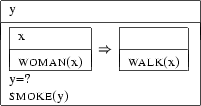11.2.2 Accessibility Constraints
The structure of DSRs helps to formulate accessibility constraints.
The structure of DRSs plays a crucial role in pronoun resolution. In DRT, anaphoric pronouns are only allowed to refer to discourse referents that are accessible. As we will see shortly, DRSs are defined recursively, and accessibility is defined in terms of how the DRSs are nested into each other. Consider the following discourse and its DRS translation:
``Every woman walks. *She smokes.''

This DRSs contains one complex condition, where two DRSs are conjoined by the  operator. This implicational condition can be interpreted as follows: if we are able to extend the current situation with an entity having the property of being a woman, then this entity must walk. This complex condition is triggered by the use of the universal quantifier ``every'', and has interesting consequences for pronoun resolution.
operator. This implicational condition can be interpreted as follows: if we are able to extend the current situation with an entity having the property of being a woman, then this entity must walk. This complex condition is triggered by the use of the universal quantifier ``every'', and has interesting consequences for pronoun resolution.
Now, what DRT stipulates is that discourse referents introduced by anaphoric pronouns can only establish links with accessible discourse referents. The discourse referent x introduced by ``Every woman'' is not accessible from the viewpoint of discourse referent y, introduced by the pronoun ``She'', because it is declared at a level deeper than the discourse referent of the pronoun. Hence DRT predicts that ``every woman'' is not allowed as antecedent for the anaphoric pronoun ``she''. (And this is correct, hence the  in the example).
in the example).
But what exactly pins down this idea of accessibility? Before discussing some more examples, let's first give a formal definition of the syntax of DRSs and then define accessibility more precisely.